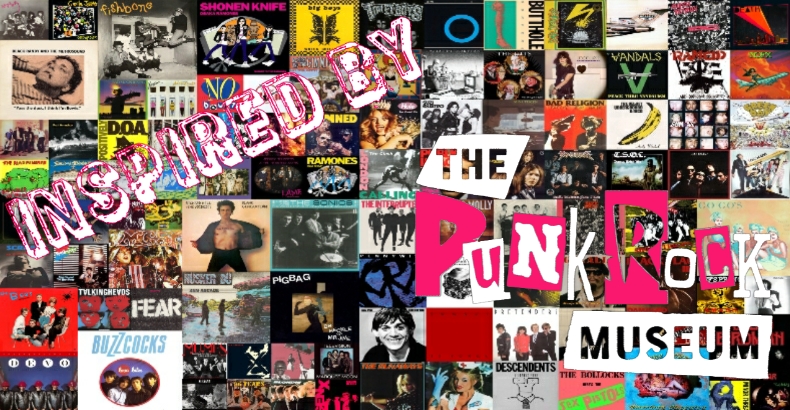As I was getting myself into the proper mindset to visit and process everything I was going to be soaking in at The Punk Rock Museum, a couple weeks ago, I began putting together a playlist and played it in the car on my way to and from the museum. Then, after I got home, to have something to play while I was writing about my experience, I expanded the playlist, extensively, incorporating artists that I’d neglected to include, earlier. The now 200-song playlist, entitled Inspired by The Punk Rock Museum, while expansive—it spans many of the flavors of punk rock, including proto-punk, punk, ska-punk, punk blues, pop punk, folk punk, no wave, grunge, punk revival, and alternative rock—is simply my summary of a particularly broad genre. To wit, if I don't particularly care for a song, it doesn't appear. You'll also find a lot of covers, as punk artists seem to love them almost as much as I enjoy hearing them (when done well or particularly humorously). Thus, to give the whole thing some context, here is a very broad look at the movement and the music.
You’ll find songs from the proto-punks, outfits whose music and attitudes laid the foundation for the punk movement. And while the classification “proto-punk” could only be ascribed after the occurrence of punk, itself; in retrospect, we now use the term when speaking of such bands as New York’s Velvet Underground, Patti Smith, and the New York Dolls; and Detroit bands MC5, the Stooges, and Death; as well as bands like Los Saicos (from Lima, Peru), and the Sonics (from Tacoma, WA) that might not be as familiar to most listeners, but were no less influential to the movement than their big city counterparts.
Over in the UK, the Doctors of Madness, the Stranglers, Cock Sparer, and Dr. Feelgood were blazing the trail; while down in Australia, it was the Saints and Radio Birdman causing all the ruckus. And let’s not forget ? and the Mysterions, one of the first bands about which the expressions “punk” and “rock” were first linked together, (in a 1971 review by noted music critic, Dave Marsh, then the editor of Creem, who wrote about how taken aback he was with the way Question Mark insulted his audience).
And then along came punk, the genre from which the bulk of the songs on this playlist come. First with the Ramones and the Richard Hell-led bands Television, the Heartbreakers, and the Voidoids, in New York; as well as the Cramps and the Dead Boys, in Ohio. Shortly thereafter, the Malcolm McLaren-managed Sex Pistols hacked a loogie on the world, while John Graham Mellor left The 101ers, changed his name to ‘Joe Strummer’ and joined a newly-formed band called the Clash. Siouxsie and the Banshees howled, X-Ray Spex shrieked, and the Slits, Generation X, the Damned, and Buzzcocks reverberated with the spark of punk’s first wave.
Back in the good ol’ US of A, the California scene was lighting up, thanks to the likes of the Germs, Black Randy and the Metrosquad, the Dickies, X, FEAR, The Go-Go’s, and Black Flag; and in New Jersey, the Misfits were debuting their signature creepy vibe.
Hardcore [think: moshing] became a thing in the late ‘70s, and is represented on this playlist by Bad Brains and Minor Threat (Washington, D.C.), Big Boys (Austin, TX), Dead Kennedys (San Francisco, CA), D.O.A. (Vancouver, B.C.), Circle Jerks, Suicidal Tendencies, Youth Brigade, and Bad Religion (Los Angeles, CA), Descendents (Manhattan Beach, CA), Red Kross (Hawthorne, CA), T.S.O.L. (Long Beach, CA), Agent Orange (Placentia, CA), the Minutemen (San Pedro, CA), and Social Distortion (Fullerton, CA); followed shortly thereafter by Hüsker Dü and the Replacements (Minneapolis/St. Paul, MN), as well as the Beastie Boys, the Cro-Mags, and Murphy’s Law (New York, NY).
There are further punk subcultures on this playlist (most of which can be corralled under the umbrella of “alternative rock”), as represented by Gun Club (punk blues), the Cramps (psychobilly), Violent Femmes and the Pogues (folk punk), Sonic Youth (no wave), L7 and Bikini Kill (riot grrrl), Green Day, Rancid, NOFX, and the Offspring (punk revival), No Doubt (ska-punk), blink-182 (pop punk), and the Gits and Nirvana (grunge rock).
What one might not expect from a genre too often associated with cis white males, is the prevalence of bands made up of artists of every imaginable race, gender and sexual orientation. In other words, no matter how you might identify, this playlist includes a punk band that features representation for you.
The members of Death and Bad Brains (now Soul Brains) and Fishbone are Black, as were certain members of Dead Kennedys. Shonen Knife is a female punk band from Japan. Suicidal Tendencies had any number of members who were Black or Latino; while Black Flag had three Latino members and a female bassist. Meanwhile, gay Latino punk rocker, Brian Tristan (aka ‘Kid Congo Powers’) has been a member of Gun Club and the Cramps.
Max’s Kansas City mainstay, Wayne County, famously went to Berlin and returned as Jayne County—her autobiography, Man Enough to be a Woman, became the source material for John Cameron Mitchell’s Hedwig and the Angry Inch—thereby paving the way for such trans punk rockers as Laura Jane Grace of Against Me!, and Lucas Silviera of the Cliks. And on the drag front, Squeezebox gave us the sensational Miss Guy and the Toilet Boys. Then there were The B-52s, whose members of both genders have been gay, straight, and bi (depending on the decade).
And don’t even consider downplaying the role of women in punk rock (and most certainly neither at The Punk Rock Museum nor on this playlist)! Nobody could rightly dispute the punk rock bona fides of Patti Smith, Debbie Harry of Blonde, or Chrissy Hynde of Pretenders. Suzy Quatro canned the can, and the Runaways remain one of the fiercest punk outfits, ever, with Joan Jett a forever punk deity. The Go-Go’s debut album, Beauty and the Beat was the first and—more than forty years later—the only album to top the Billboard album chart by an all-female band whose members wrote their own material and played their own instruments.
Anyone who hears Siouxsie Sioux sing continues to fall immediately under her spell, while anyone who hears Nina Hagen sing is simultaneously awed, confused, and amused. In true punk rock fashion, L7 split up for a decade-and-a-half, then got back together, to rock harder than ever before [catch them headlining next month’s Punk Rock Bowling weekend, along with Rancid, Fishbone, Bad Religion, the Damned, Suicidal Tendencies, and punk cover maestros Me First and the Gimme Gimmes!].
X’s Exene Cervenka remains a force of nature, while Poly Styrene’s cry of “Oh Bondage Up Yours!” on the X-Ray Spex song of the same name became a punk rallying cry of feminist liberation for the ages. The balaclava-wearing members of Pussy Riot were arrested, held without bail, and finally imprisoned in their native Russia (while being named ‘prisoners of consciousness’ by Amnesty International). Cherry Vanilla talked the talk, and Lydia Lunch sounded off with poetry. And no list of punks would be complete without Courtney Love, because frankly, if you can listen to “Violet” without feeling the power radiating from Love as she vents her bilious rage toward her ex, then you might be empathically deficient and a little bit dead inside. (“Violet” really makes everyone who carries on about how bad Taylor Swift’s exes have it seem silly by comparison.)
So, whether you’ve been a longtime punk rocker, are just curious to hear some great songs (and some admittedly ear-splitting ones), or want a quick primer on the genre, Inspired by The Punk Rock Museum is the playlist for you. Enjoy! *
Inspired by The Punk Rock Museum
Click HERE for Apple Music
Click HERE for Spotify
Get into it!
#PunkRock
[Editor’s Note: * In keeping with the punk theme, if you choose not to enjoy it—which is your prerogative, to be sure—then might I suggest that you take direction from the title of my favorite Jayne County song, and “F**k Off!”]








